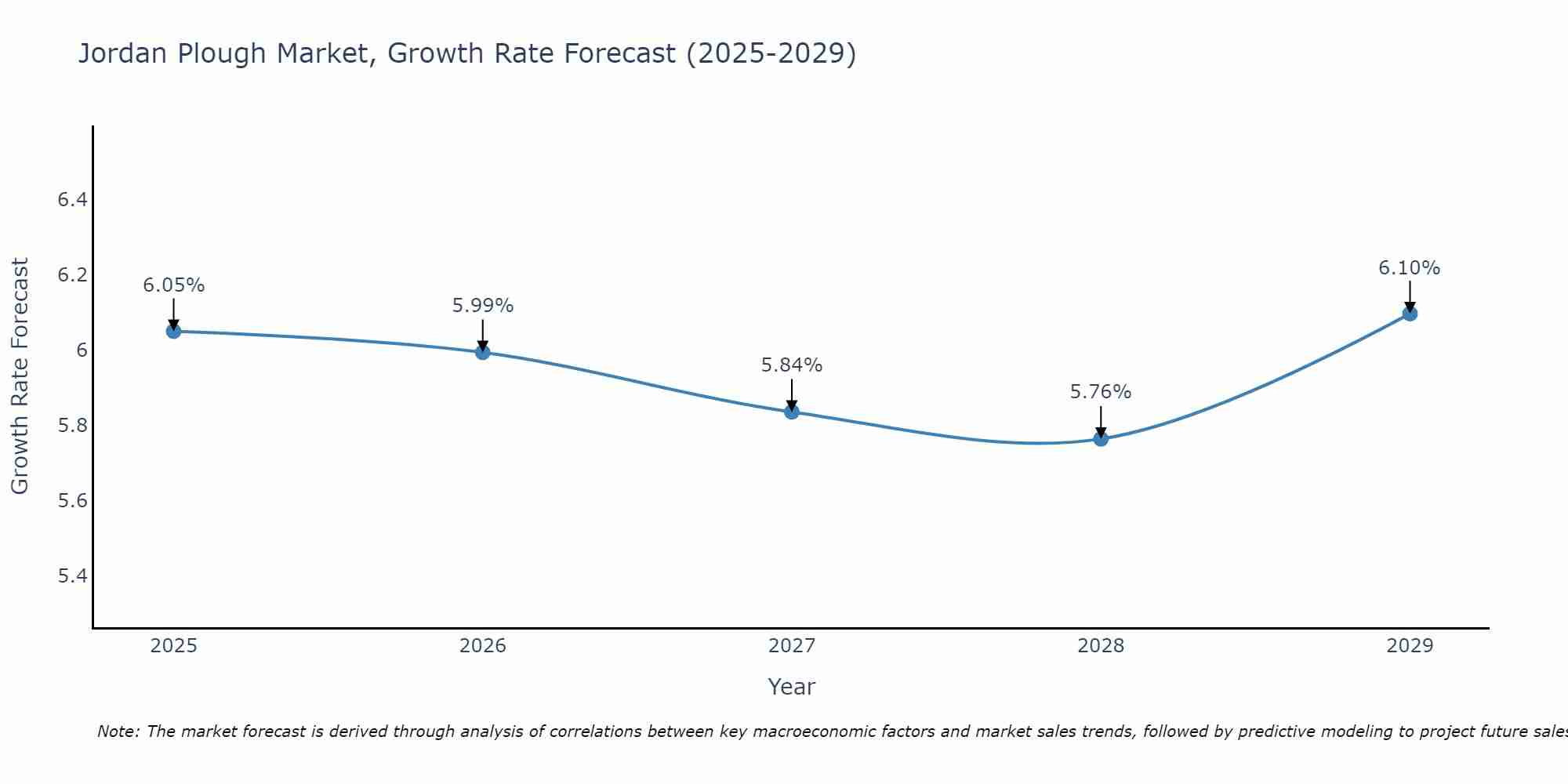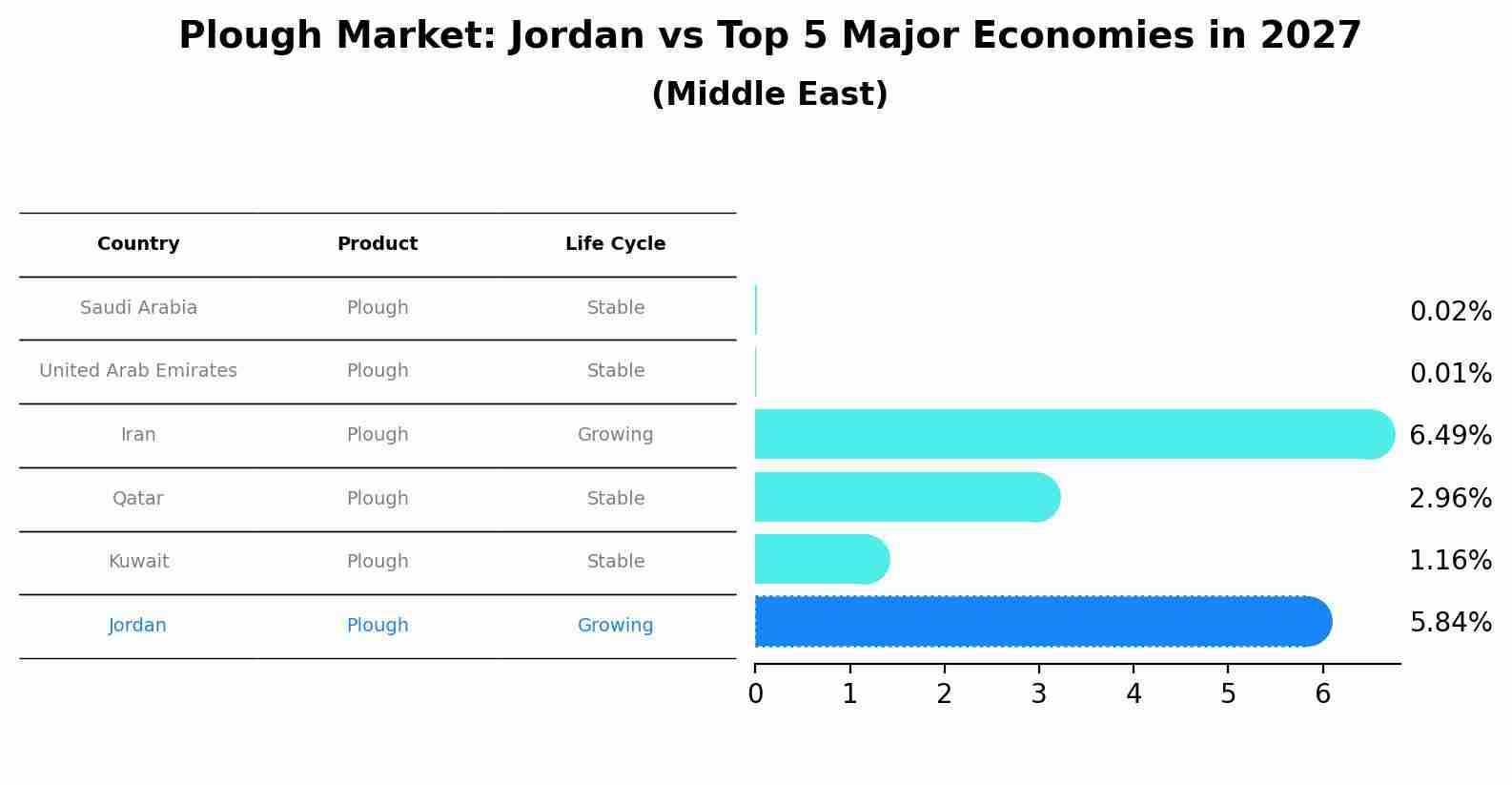Jordan Plough Market (2025-2031) | Industry, Trends, Analysis, Revenue, Companies, Share, Forecast, Outlook, Size, Value & Growth
| Product Code: ETC051506 | Publication Date: Jan 2021 | Updated Date: Jun 2025 | Product Type: Report | |
| Publisher: 6Wresearch | Author: Summon Dutta | No. of Pages: 70 | No. of Figures: 35 | No. of Tables: 5 |
Jordan Plough Market Size Growth Rate
The Jordan Plough Market is projected to witness mixed growth rate patterns during 2025 to 2029. From 6.05% in 2025, the growth rate steadily ascends to 6.10% in 2029.

Plough Market: Jordan vs Top 5 Major Economies in 2027 (Middle East)
The Plough market in Jordan is projected to grow at a growing growth rate of 5.84% by 2027, highlighting the country's increasing focus on advanced technologies within the Middle East region, where Saudi Arabia holds the dominant position, followed closely by United Arab Emirates, Iran, Qatar and Kuwait, shaping overall regional demand.

Jordan Plough Market Overview
The Jordan Plough Market is a competitive and growing industry within the agricultural sector, primarily focusing on the manufacturing and distribution of ploughing equipment for farmers in Jordan. The market is characterized by a diverse range of players, including both local manufacturers and international brands. Key market trends include the increasing adoption of advanced ploughing technologies to enhance efficiency and productivity in farming practices, as well as a growing emphasis on sustainability and environmental conservation. Market players are also investing in research and development to introduce innovative features and designs to cater to the evolving needs of farmers. Overall, the Jordan Plough Market is poised for continued growth driven by the country`s reliance on agriculture as a key economic activity and the increasing mechanization of farming practices.
Jordan Plough Market Trends
The Jordan Plough market is currently experiencing a surge in demand for advanced ploughing technology that improves efficiency and productivity. Farmers are increasingly seeking ploughs with features such as GPS guidance systems, variable working widths, and automatic depth control to optimize field operations. Sustainability is also a key trend, with a growing preference for eco-friendly ploughs that reduce soil compaction and fuel consumption. Additionally, there is a rising interest in compact and lightweight ploughs that are suitable for small-scale farming operations. Manufacturers are focusing on innovation and product development to meet these evolving market demands and provide farmers with modern, efficient, and environmentally friendly ploughing solutions.
Jordan Plough Market Challenges
In the Jordan plough market, some challenges that are commonly faced include intense competition from both local and international manufacturers, fluctuations in raw material prices, and the need to constantly innovate to meet changing customer preferences. Additionally, regulatory hurdles and compliance requirements can also pose challenges for companies operating in the market. Limited access to financing and technology advancements, as well as the impact of economic conditions and political instability in the region, can further complicate the business environment for players in the Jordan plough market. Overall, companies in this market need to navigate through a complex landscape of challenges to stay competitive and sustain growth.
Jordan Plough Market Investment Opportunities
The Jordan plough market presents various investment opportunities for both local and international investors. With the increasing demand for agricultural products in the region, investing in advanced plough technologies and equipment can be lucrative. Additionally, there is a growing trend towards sustainable and environmentally friendly agriculture practices, creating opportunities for investments in eco-friendly ploughing solutions. Collaborating with local farmers to provide modern ploughing services or establishing ploughing service businesses can also be profitable ventures. Furthermore, investing in research and development for innovative ploughing techniques tailored to the specific needs of Jordanian agriculture can yield long-term returns. Overall, the Jordan plough market offers diverse investment prospects for those looking to capitalize on the country`s agricultural sector`s growth potential.
Jordan Plough Market Government Policy
The Jordanian government has implemented various policies to support the agricultural sector, including the plough market. These policies aim to promote sustainable farming practices, increase productivity, and ensure food security. Subsidies are provided for agricultural inputs such as seeds, fertilizers, and machinery to support small-scale farmers. Additionally, the government has introduced programs to modernize the sector, improve irrigation systems, and promote the use of advanced technology in farming practices. Regulatory measures are also in place to ensure fair pricing and market access for farmers in the plough market. Overall, the government is committed to enhancing the competitiveness and resilience of the agricultural sector, including the plough market, through supportive policies and initiatives.
Jordan Plough Market Future Outlook
The future outlook for the Jordan Plough Market appears promising, driven by a combination of factors. The increasing adoption of modern agricultural practices and machinery, coupled with a growing focus on sustainable farming methods, is expected to drive demand for advanced ploughing equipment in the region. Additionally, government initiatives to support small-scale farmers and promote agricultural productivity are likely to boost market growth. Technological advancements in plough design and functionality, such as precision farming and GPS integration, are also anticipated to contribute to market expansion. Overall, the Jordan Plough Market is poised for steady growth in the coming years, with opportunities for manufacturers to innovate and cater to evolving customer needs in the agricultural sector.
Key Highlights of the Report:
- Jordan Plough Market Outlook
- Market Size of Jordan Plough Market, 2024
- Forecast of Jordan Plough Market, 2031
- Historical Data and Forecast of Jordan Plough Revenues & Volume for the Period 2021 - 2031
- Jordan Plough Market Trend Evolution
- Jordan Plough Market Drivers and Challenges
- Jordan Plough Price Trends
- Jordan Plough Porter's Five Forces
- Jordan Plough Industry Life Cycle
- Historical Data and Forecast of Jordan Plough Market Revenues & Volume By Types for the Period 2021 - 2031
- Historical Data and Forecast of Jordan Plough Market Revenues & Volume By Traditional Plough for the Period 2021 - 2031
- Historical Data and Forecast of Jordan Plough Market Revenues & Volume By Modern Plough for the Period 2021 - 2031
- Historical Data and Forecast of Jordan Plough Market Revenues & Volume By Specialist Plough for the Period 2021 - 2031
- Historical Data and Forecast of Jordan Plough Market Revenues & Volume By Application for the Period 2021 - 2031
- Historical Data and Forecast of Jordan Plough Market Revenues & Volume By Farm for the Period 2021 - 2031
- Historical Data and Forecast of Jordan Plough Market Revenues & Volume By Individual Farming for the Period 2021 - 2031
- Jordan Plough Import Export Trade Statistics
- Market Opportunity Assessment By Types
- Market Opportunity Assessment By Application
- Jordan Plough Top Companies Market Share
- Jordan Plough Competitive Benchmarking By Technical and Operational Parameters
- Jordan Plough Company Profiles
- Jordan Plough Key Strategic Recommendations
Frequently Asked Questions About the Market Study (FAQs):
1 Executive Summary |
2 Introduction |
2.1 Key Highlights of the Report |
2.2 Report Description |
2.3 Market Scope & Segmentation |
2.4 Research Methodology |
2.5 Assumptions |
3 Jordan Plough Market Overview |
3.1 Jordan Country Macro Economic Indicators |
3.2 Jordan Plough Market Revenues & Volume, 2024 & 2031F |
3.3 Jordan Plough Market - Industry Life Cycle |
3.4 Jordan Plough Market - Porter's Five Forces |
3.5 Jordan Plough Market Revenues & Volume Share, By Types, 2024 & 2031F |
3.6 Jordan Plough Market Revenues & Volume Share, By Application, 2024 & 2031F |
4 Jordan Plough Market Dynamics |
4.1 Impact Analysis |
4.2 Market Drivers |
4.3 Market Restraints |
5 Jordan Plough Market Trends |
6 Jordan Plough Market, By Types |
6.1 Jordan Plough Market, By Types |
6.1.1 Overview and Analysis |
6.1.2 Jordan Plough Market Revenues & Volume, By Types, 2016 - 2031F |
6.1.3 Jordan Plough Market Revenues & Volume, By Traditional Plough, 2016 - 2031F |
6.1.4 Jordan Plough Market Revenues & Volume, By Modern Plough, 2016 - 2031F |
6.1.5 Jordan Plough Market Revenues & Volume, By Specialist Plough, 2016 - 2031F |
6.2 Jordan Plough Market, By Application |
6.2.1 Overview and Analysis |
6.2.2 Jordan Plough Market Revenues & Volume, By Farm, 2016 - 2031F |
6.2.3 Jordan Plough Market Revenues & Volume, By Individual Farming, 2016 - 2031F |
7 Jordan Plough Market Import-Export Trade Statistics |
7.1 Jordan Plough Market Export to Major Countries |
7.2 Jordan Plough Market Imports from Major Countries |
8 Jordan Plough Market Key Performance Indicators |
9 Jordan Plough Market - Opportunity Assessment |
9.1 Jordan Plough Market Opportunity Assessment, By Types, 2024 & 2031F |
9.2 Jordan Plough Market Opportunity Assessment, By Application, 2024 & 2031F |
10 Jordan Plough Market - Competitive Landscape |
10.1 Jordan Plough Market Revenue Share, By Companies, 2024 |
10.2 Jordan Plough Market Competitive Benchmarking, By Operating and Technical Parameters |
11 Company Profiles |
12 Recommendations |
13 Disclaimer |
- Single User License$ 1,995
- Department License$ 2,400
- Site License$ 3,120
- Global License$ 3,795
Search
Thought Leadership and Analyst Meet
Our Clients
Related Reports
- Germany Breakfast Food Market (2026-2032) | Industry, Share, Growth, Size, Companies, Value, Analysis, Revenue, Trends, Forecast & Outlook
- Australia Briquette Market (2025-2031) | Growth, Size, Revenue, Forecast, Analysis, Trends, Value, Share, Industry & Companies
- Vietnam System Integrator Market (2025-2031) | Size, Companies, Analysis, Industry, Value, Forecast, Growth, Trends, Revenue & Share
- ASEAN and Thailand Brain Health Supplements Market (2025-2031) | Strategy, Consumer Insights, Analysis, Investment Trends, Opportunities, Growth, Size, Share, Industry, Revenue, Segments, Value, Segmentation, Supply, Forecast, Restraints, Outlook, Competition, Drivers, Trends, Demand, Pricing Analysis, Competitive, Strategic Insights, Companies, Challenges
- ASEAN Bearings Market (2025-2031) | Strategy, Consumer Insights, Analysis, Investment Trends, Opportunities, Growth, Size, Share, Industry, Revenue, Segments, Value, Segmentation, Supply, Forecast, Restraints, Outlook, Competition, Drivers, Trends, Demand, Pricing Analysis, Competitive, Strategic Insights, Companies, Challenges
- Europe Flooring Market (2025-2031) | Outlook, Share, Industry, Trends, Forecast, Companies, Revenue, Size, Analysis, Growth & Value
- Saudi Arabia Manlift Market (2025-2031) | Outlook, Size, Growth, Trends, Companies, Industry, Revenue, Value, Share, Forecast & Analysis
- Uganda Excavator, Crane, and Wheel Loaders Market (2025-2031) | Strategy, Consumer Insights, Analysis, Investment Trends, Opportunities, Growth, Size, Share, Industry, Revenue, Segments, Value, Segmentation, Supply, Forecast, Restraints, Outlook, Competition, Drivers, Trends, Demand, Pricing Analysis, Competitive, Strategic Insights, Companies, Challenges
- Rwanda Excavator, Crane, and Wheel Loaders Market (2025-2031) | Strategy, Consumer Insights, Analysis, Investment Trends, Opportunities, Growth, Size, Share, Industry, Revenue, Segments, Value, Segmentation, Supply, Forecast, Restraints, Outlook, Competition, Drivers, Trends, Demand, Pricing Analysis, Competitive, Strategic Insights, Companies, Challenges
- Kenya Excavator, Crane, and Wheel Loaders Market (2025-2031) | Strategy, Consumer Insights, Analysis, Investment Trends, Opportunities, Growth, Size, Share, Industry, Revenue, Segments, Value, Segmentation, Supply, Forecast, Restraints, Outlook, Competition, Drivers, Trends, Demand, Pricing Analysis, Competitive, Strategic Insights, Companies, Challenges
Industry Events and Analyst Meet
Whitepaper
- Middle East & Africa Commercial Security Market Click here to view more.
- Middle East & Africa Fire Safety Systems & Equipment Market Click here to view more.
- GCC Drone Market Click here to view more.
- Middle East Lighting Fixture Market Click here to view more.
- GCC Physical & Perimeter Security Market Click here to view more.
6WResearch In News
- Doha a strategic location for EV manufacturing hub: IPA Qatar
- Demand for luxury TVs surging in the GCC, says Samsung
- Empowering Growth: The Thriving Journey of Bangladesh’s Cable Industry
- Demand for luxury TVs surging in the GCC, says Samsung
- Video call with a traditional healer? Once unthinkable, it’s now common in South Africa
- Intelligent Buildings To Smooth GCC’s Path To Net Zero


















